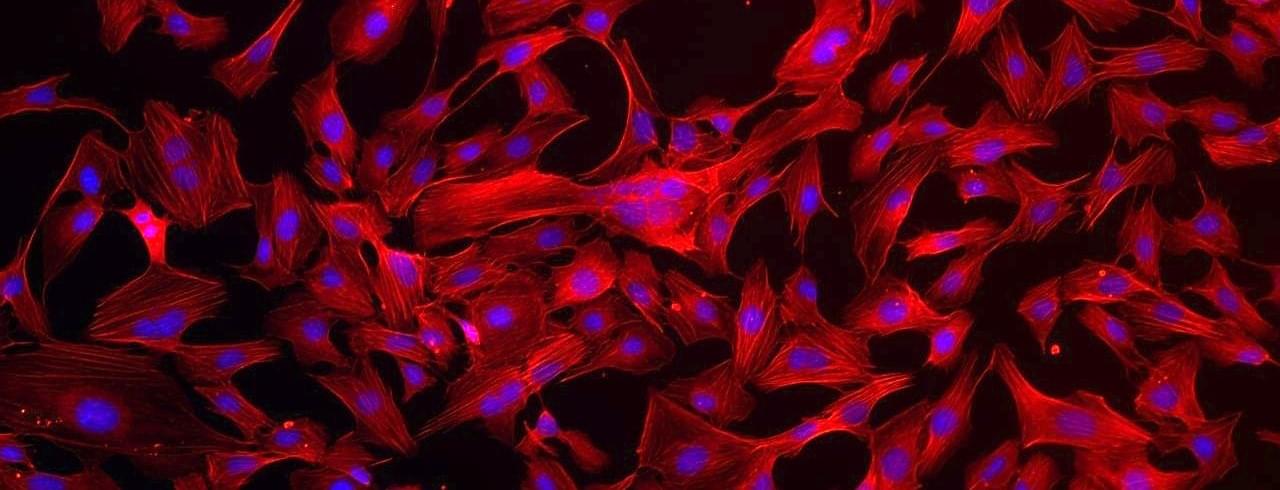Endothelial Cells

Endothelial cells are cells that line the inner surface of blood vessels and lymphatic vessels, forming an interface between circulating blood or lymph in the lumen and the rest of the vessel wall. The endothelial cells serve as a permeable barrier to regulate the passage of substances between blood-stream and surrounding tissue. In basic research, endothelial cells are critical in applications related to wound healing, angiogenesis, blood brain barrier (BBB), inflammatory processes, diabetes and other cardiovascular diseases.
Human Umbilical Vein Endothelial Cells (HUVECs)
The human umbilical cord has become one of the most important sources of vascular endothelial cells. The availability of these cells has played a major role in the development of the field of vascular biology.
HUVECs have provided a critical in vitro model for major breakthroughs in the pathophysiology of atherosclerosis and plaque formation, and mechanisms for the control of angiogenesis or neovascularization in response to hypoxia and inflammation in tumors, ischemic tissue, and in embryogenesis.
Coronary Artery Endothelial Cells (CAECs)
The coronary arteries provide abundant blood supply to meet the enormous energy demands of the heart’s sustained contraction activity. Coronary artery endothelial cells (CAECs) are continuously exposed to fluid shear stress, causing changes in cell morphology and producing endothelium-derived substances that regulate vasoconstriction and vessel growth. CAECs can also modulate the expression of cellular adhesion molecules to control and fine-tune inflammatory response and fibrinolysis. These physiological properties make CAECs widely used in the study of mechanisms for endothelium dysfunction, pathogenesis of coronary heart disease and atherosclerosis, and the development of novel disease treatments.
Aortic Endothelial Cells (AECs)
The aorta is the largest artery in the body, which transports oxygenated blood from the heart to all parts of the body. Aortic endothelial cells (AECs) provide an excellent model system for studying cardiovascular function and disease, and they have been used in research of diabetes-associated complications related to cardiovascular function, immune response mechanisms and graft rejection, as well as 3D endothelialized engineering tissues.
Human Lung Microvascular Endothelial Cells (HLMECs) The lung microvascular endothelial cells (LMECs) are isolated from human pulmonary arteries. The LMECs form a semi-selective barrier that is essential for gas exchange and regulation of fluid and solute passage between blood and interstitial compartments in the lung.
HLMECs have been used to study the pathology and biology of the pulmonary microvasculature in vitro. The pulmonary vasculature is of great physiological/pathological significance, which is recognized to be a tissue composed of metabolically active, functionally responsive cells that interact with the circulating matrix and regulate the composition of systemic arterial blood, affect target organ functions, and contribute to thrombosis, hemostasis and immune reactions, as well as tumor metastasis.
At Creative Bioarray, we provide a reliable and reproducible endothelial cell resources for vascular disease modeling, drug screening, and vascular tissue engineering applications.
Endothelial cells from Creative Bioarray have been isolated from human normal, diseased donors of various tissues and animals such as mouse, rat, monkey and bovine with high purity, low passage, rigorous characterization and performance tested. Those cells have numerous applications as below:
| ☆ | Vascular Biology |
| ☆ | Inflammation |
| ☆ | Angiogenesis |
| ☆ | Atherosclerosis |
| ☆ | Blood clotting |
| ☆ | Vasoconstriction and vasodilation |
| ☆ | Tubule formation assays |
At Creative Bioarray, we offer high-quality Endothelial Cell Growth Medium to support your research.
Description: Aged Mouse Aortic Endothelial Cells are isolated from aorta of pathogen-free laboratory mice of ...
Description: Aged Mouse Artery Endothelial Cells are isolated from artery of pathogen-free laboratory mice of ...
Description: Aged Mouse Bladder Microvascular Endothelial Cells are isolated from bladder of pathogen-free ...
Description: Aged Mouse Bone Marrow-Derived Endothelial Cells are isolated from bone of pathogen-free laboratory ...
Description: Aged Mouse Brain Microvascular Endothelial Cells are isolated from brain of pathogen-free ...
Description: Aged Mouse Cardiac Microvascular Endothelial Cells are isolated from cardiac of pathogen-free ...
Description: Aged Mouse Colonic Microvascular Endothelial Cells are isolated from colon of pathogen-free ...
Description: Aged Mouse Coronary Artery Endothelial Cells from Creative Bioarray are isolated from coronary of ...
Description: Aged Mouse Dermal Lymphatic Endothelial Cells are isolated from dermal of pathogen-free laboratory ...
Description: Aged Mouse Dermal Microvascular Endothelial Cells are isolated from dermal of pathogen-free ...
Description: Aged Mouse Intestinal Mesenteric Vascular Endothelial Cells are isolated from intestinal of ...
Description: Aged Mouse Kidney Endothelial Cells are isolated from kidney of pathogen-free laboratory mice of ...
Description: Aged Mouse Kidney Glomerular Endothelial Cells are isolated from kidney of pathogen-free laboratory ...
Description: Aged Mouse Liver Sinusoidal Endothelial Cells are isolated from liver of pathogen-free laboratory ...
Description: Aged Mouse Lung Microvascular Endothelial Cells are isolated from lung of pathogen-free laboratory ...
Description: Aged Mouse Lymphatic Endothelial Cells are isolated from lymphatic of pathogen-free laboratory mice ...
Description: Aged Mouse Mammary Microvascular Endothelial Cells are isolated from mammary of pathogen-free ...
Description: Aged Mouse Ovarian Endothelial Cells are isolated from ovarian of pathogen-free laboratory mice of ...